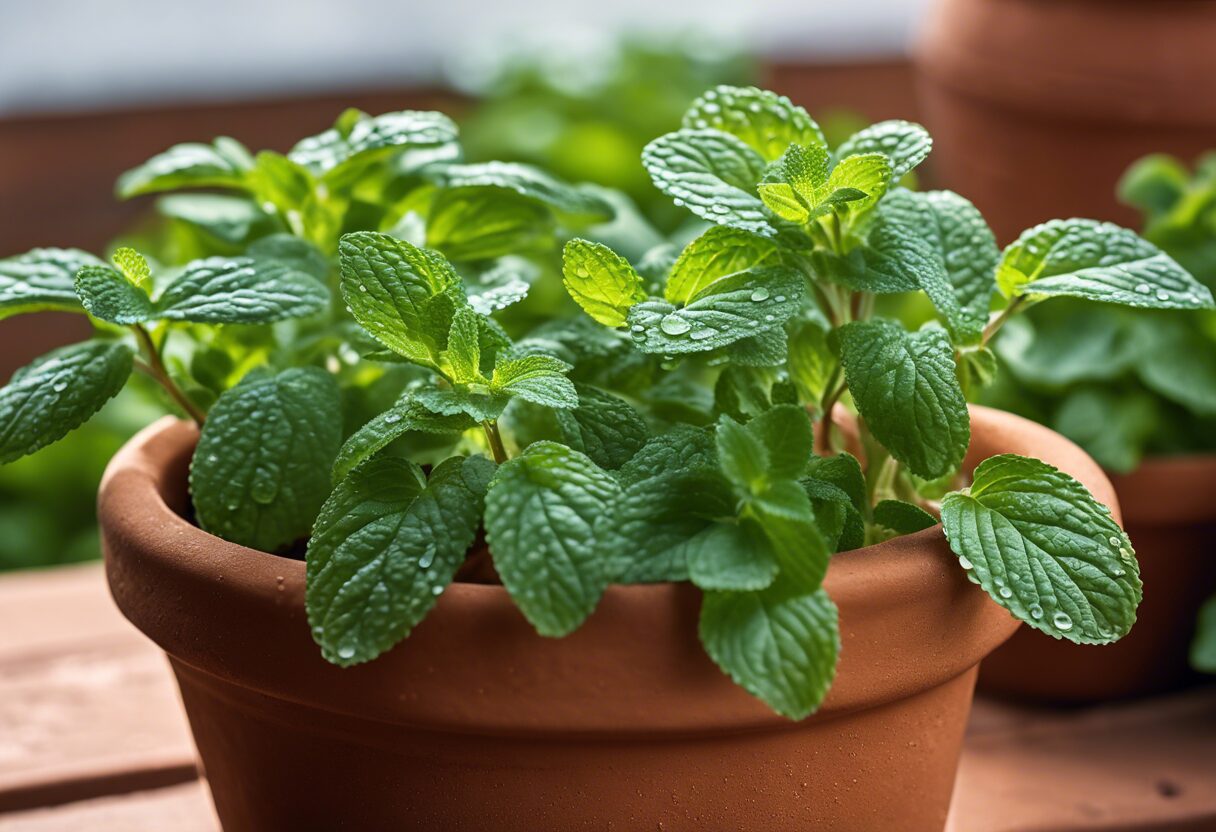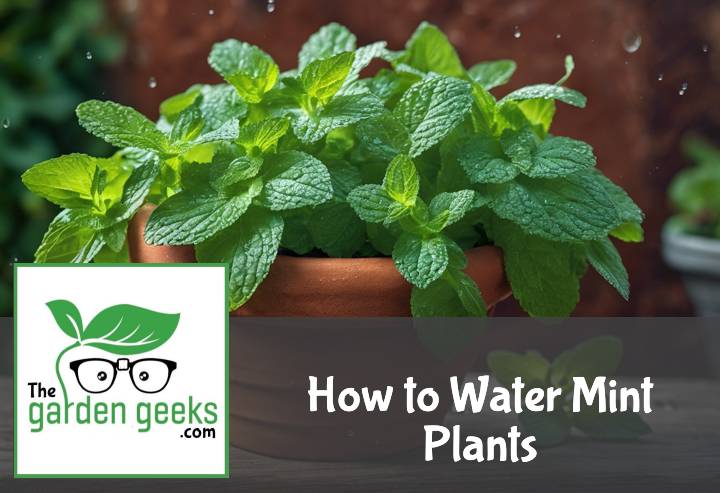Ever found yourself in a pickle, wondering How to Water Mint Plants? Well, buckle up buttercup, ’cause we’re about to dive into the minty-fresh world of proper plant watering.
In this guide, we’ll be spilling the tea on how to keep your mint plants hydrated and happy. So stick around if you’re thirsty for some knowledge! “Keep reading about How to Water Mint Plants”.
Key Takeaways
- Mint plants prefer a moist environment, so water them regularly.
- Watering should be done early in the morning to prevent evaporation.
- The soil should be kept consistently damp but not waterlogged.
- Overwatering can lead to root rot, so ensure proper drainage.
- During winter, reduce watering as mint plants enter dormancy.
- Use a spray bottle for indoor mint plants to maintain humidity.

Understanding Mint Plants
Mint plants are quite the charmers, aren’t they? They’re like that friend who’s always up for a drink – in this case, water. Watering mint plants is crucial to their overall health and growth. It’s like their daily cup of joe, without which they’d be all grumpy and wilted.
The Importance of Water for Mint Plants
Now, why is water so important for these green buddies? Well, it plays a key role in photosynthesis, the process by which plants make food. Without enough water, photosynthesis would slow down, leaving your mint plant hungry and weak.
But that’s not all! Water also helps in nutrient absorption. It acts as a vehicle, transporting essential nutrients from the soil to different parts of the plant. So when you’re watering your mint plant, you’re not just quenching its thirst but also feeding it.
Characteristics of Mint Plants Related to Watering
Let’s dive into some specific traits of mint plants that affect their watering needs. First off, their root structure. Mint plants have a sprawling root system that loves to explore and absorb moisture from the soil.
Then we have leaf composition. The leaves of mint plants are pretty thick and fleshy – kind of like tiny water storage tanks! This means they can hold onto water longer than other plants might be able to.
So there you have it! A little insight into how to water mint plants based on their unique characteristics. Remember folks, understanding your plant is half the battle won!
When to Water Mint Plants?


Timing is everything when it comes to watering mint plants. You’ve got to keep an eye on the soil and adjust your mint plant watering schedule based on the season.
Identifying Dry Soil
So, how do you know when your mint plant is thirsty? Well, the soil will give you a hint. If it’s dry to touch, then it’s time for a drink. But don’t just rely on your fingers; look out for signs of dehydration in your mint plants too. Droopy leaves or browning at the edges could mean your plant is parched. So, check that soil moisture for mint regularly and water accordingly.
Seasonal Considerations for Watering Mint Plants
Now let’s talk seasons because they play a big role in how to water mint plants. In summer, when the sun is blazing and temperatures are high, your mint might need more frequent watering. On the other hand, during winter months when growth slows down and light levels dip, cut back on watering to avoid over-saturating the soil. Remember folks, adjusting water for mint per season isn’t rocket science; it’s all about observation and adjustment!
If you like to better visualise it, lets check this table
| Condition | Watering Frequency | Details |
|---|---|---|
| Standard Outdoor | Every 2 to 3 days | Water more frequently in hot, dry weather. Mint prefers consistently moist soil. |
| Indoor/Container | Every 1 to 2 weeks | Check the top inch of soil; water when it feels dry. Containers dry out faster than garden soil. |
| High Humidity | Every 1 to 2 weeks | In humid conditions, soil retains moisture longer. Adjust watering to prevent waterlogged soil. |
| Low Humidity/Air | Every 2 to 3 days | Dry air and soil mean Mint will need more frequent watering to stay hydrated. |
| Bright, Direct Sunlight | Every 2 to 3 days | Direct sunlight increases evaporation, so Mint may require more frequent watering. |
| Partial Shade | Every 1 to 2 weeks | In less intense light, Mint requires less frequent watering. |
| Cool Temperatures | Every 1 to 2 weeks | Mint in cooler temperatures will require less frequent watering compared to growing in hot conditions. |
| After Repotting | Immediately, then monitor | Water thoroughly after repotting, then adjust to regular watering schedule once the top inch of soil is dry. |
| Winter/Dormant Period | Every 2 to 4 weeks | Mint’s water needs decrease significantly during its dormant period in winter. |



How Much Water Do Mint Plants Need?
When it comes to mint plant care, knowing how much water your mint needs is crucial. It’s a balancing act, really. Too little and you’ll have a thirsty plant on your hands, too much and you risk drowning the poor thing. So, let’s dive into the nitty-gritty of watering mint plants and maintaining their hydration levels just right.
Determining the Right Amount of Water
First things first, there’s no one-size-fits-all answer when it comes to watering guidelines for mint. The amount of water your mint needs depends on several factors. If you’re living in a hot climate or if your pot is particularly large, your mint might need more water than usual.
On the other hand, if you’ve got heavy soil that retains water well, you might need to ease up on the watering can. The key here is observation – keep an eye on your plant and adjust as necessary for ideal hydration for mint plants.
Overwatering vs Underwatering: Signs and Solutions
Now let’s talk about overwatered and underwatered mints – two common issues that can plague even the most diligent gardener. Overwatered mint plants often show signs like yellow leaves or a generally sickly appearance. If you notice these symptoms, cut back on watering immediately.
Underwatered mints, however, will start wilting or drying out. In this case, increase watering gradually until the plant looks healthy again. Remember folks, fixing overwatered/underwatered mint isn’t rocket science – it just requires some keen observation and quick action!
So there you have it folks! A crash course in how to water mint plants effectively! Keep these tips in mind and your mints will be thriving in no time!
Best Practices for Watering Mint Plants
When it comes to mint plant care, proper watering is key. It’s not just about pouring water; you need to consider the type of water, the timing, and your technique. So let’s dive into how to water mint plants effectively.
Using the Right Type of Water
First off, the type of water matters a lot. Tap water might be convenient, but it often contains chlorine which isn’t great for your minty pals. If possible, use filtered water for mint plants or even better, collect some rainwater.
Rainwater is naturally soft and free from added chemicals, making it perfect for watering mint plants. But if that’s not an option, letting tap water sit overnight before using can help dissipate some of the chlorine.
Ideal Time of Day to Water Mint Plants
Next up is timing. Like us humans enjoying a cool drink on a hot day, plants prefer their H2O when it’s cooler too. The best time? Early morning or late evening.
Watering in the morning gives your mints a good start before the sun gets too intense. Evening watering helps them replenish after a long day soaking up rays. Both times ensure less evaporation and more effective hydration.
Techniques for Effective Watering
Finally, let’s talk techniques. You want to avoid overwatering while still maintaining healthy soil moisture – quite the balancing act! The trick here is to check the soil.
If it feels dry an inch below the surface – it’s time to water! And remember folks, slow and steady wins this race; give your mints a gentle soak rather than a quick splash.
By following these tips on how to water mint plants, you’ll have happy herbs thriving indoors or outdoors in no time!
Common Mistakes in Watering Mint Plants and How to Avoid Them
Alrighty, let’s dive into some common mint plant care mistakes. We’re talking about the boo-boos that can turn your lush green mint into a sad, wilted mess.
Inconsistent Watering Schedules
First up, inconsistent watering schedules. This is a biggie! Mint plants are like us humans – they love routine. When you water them haphazardly, it confuses them and can lead to poor growth or even death.
So what’s the solution? Establish a consistent watering schedule for mint. It doesn’t have to be rocket science – just pick times that work for you and stick to ’em. Remember, regular hydration is key for healthy mint plant growth.
Ignoring Weather Conditions
Next on our list of no-nos: ignoring weather conditions. Listen up folks, your mint plants aren’t oblivious to the world outside their pots! They feel the heat, they feel the cold, and their water needs change accordingly.
Hot weather means more evaporation and thirsty plants, so you’ll need to water more often. On the flip side, cold or rainy weather means less evaporation and less watering needed. So keep an eye on those skies and adjust your mint watering routine as needed!
Neglecting Drainage Requirements
Last but certainly not least: neglecting drainage requirements. You see, while mint loves water, it hates having wet feet (who doesn’t?). Too much water without proper drainage can lead to root rot – a surefire way to kill your plant.
So how do we avoid this soggy situation? Easy peasy! Just ensure you’ve got good drainage in your pots. This could mean using a pot with holes in the bottom or adding some pebbles or perlite for extra drainage.
Remember folks: when learning how to water mint plants, it’s not just about the watering itself. It’s also about avoiding these common mistakes and keeping your mint happy and healthy!


To Wrap Up
Just like a goldfish needs the right amount of food, your mint plants need the right amount of water. Remember, overwatering is like feeding your goldfish an entire pizza – not good! So now you know How to Water Mint Plants, it’s time to put that green thumb to work!
Don’t let your mint plants go thirsty or drown them in love! Balance is key. Happy watering!


